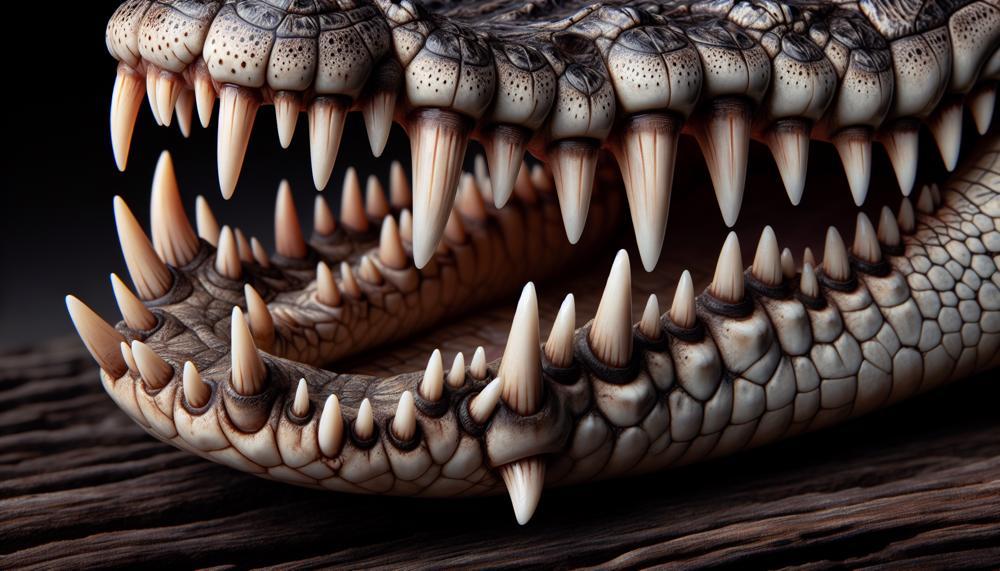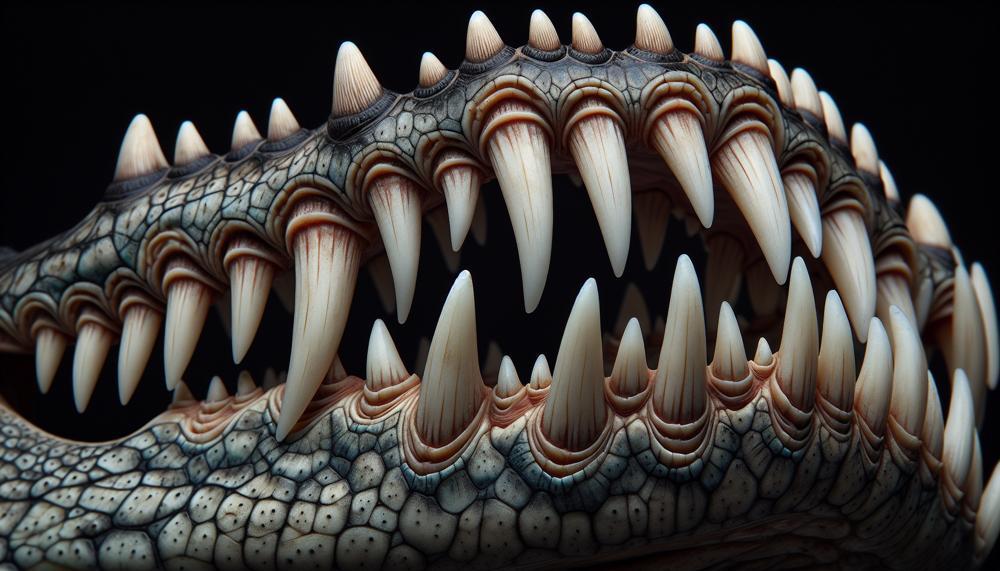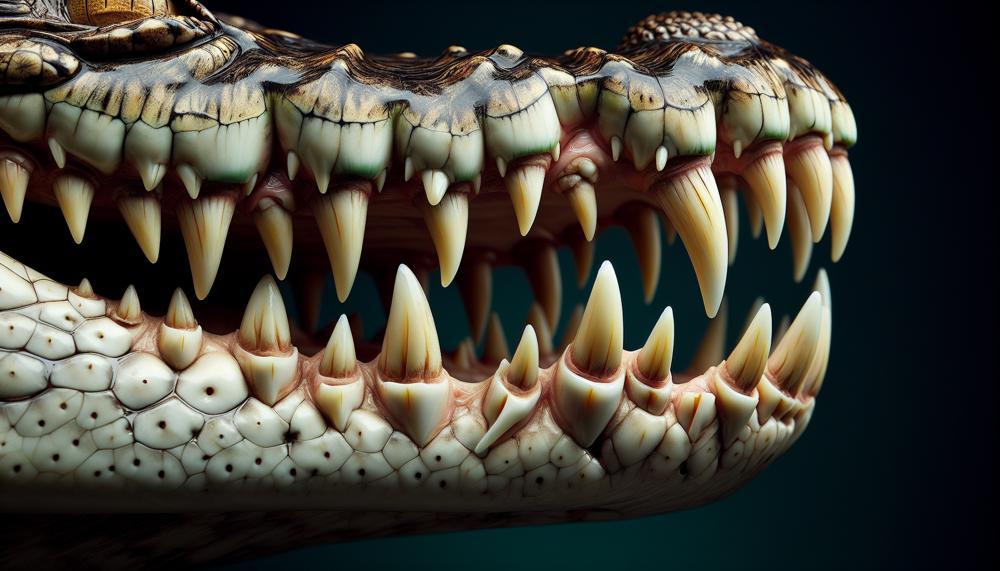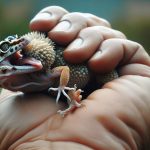Have you ever wondered how many teeth a saltwater crocodile has? These massive creatures, also known as “salties,” are not only the largest living reptiles on earth but also possess an incredible dental arsenal.
With an average of 64-68 teeth in their massive jaws, they have more teeth than any other animal on land or in water – even more than sharks. But these teeth are not just for show – they play a crucial role in hunting and survival for these ancient beasts.
What’s even more astonishing is that salties can have up to three rows of teeth on each side of their upper and lower jaws, totaling over 2,000 individual teeth throughout their lifetime.
And unlike humans who only get two sets of teeth, saltwater crocodiles continuously grow and replace their teeth throughout their lifespan. This ensures that they always have sharp and efficient weapons for catching prey.
But it’s not just the number of teeth that makes saltwater crocodiles stand out – it’s also the shape and placement of their chompers. Their triangular-shaped teeth are specifically designed for gripping and tearing prey, allowing them to exert a bite force of over 3,700 pounds per square inch. That’s enough to crush bones and tear through flesh.
With such an impressive dental arsenal, it’s no wonder that saltwater crocodiles have been able to survive for millions of years.
So, let’s get started.
Contents
How Many Teeth Do Saltwater Crocodiles Have?
The number of teeth in an adult saltwater crocodile can range anywhere from 64 to 68, with some individuals even having up to 100 teeth. This impressive number greatly surpasses other crocodile species like the Nile crocodile and American crocodile. What’s even more fascinating is that saltwater crocodiles have a unique and strategic arrangement of their teeth.
Their front teeth are sharp and curved, perfect for grasping and holding onto prey, while their back molars are blunt and used for crushing and grinding food for digestion. This specialized tooth arrangement is what makes saltwater crocodiles such successful predators in their environment.
But that’s not all – saltwater crocodiles also have a remarkable ability to regenerate lost or damaged teeth. This is made possible through a special tissue called dental lamina, which allows for continuous tooth growth throughout their lives.
This adaptation sets them apart from other species of crocodiles and ensures that they always have a full set of functional teeth at their disposal.
This unique combination of teeth arrangement and regenerative ability is what enables saltwater crocodiles to thrive in their natural habitat.
Through their powerful jaws and sharp, ever-growing teeth, these apex predators have established themselves as one of the most formidable creatures in the animal kingdom.

Is This Amount of Teeth The Same Across All Saltwater Crocodile Species?
When it comes to the number of teeth in saltwater crocodiles, there is some variation among different individuals. While the average number of teeth for this species is 64-68, there are some slight differences among specific species.
For instance, the Australian saltwater crocodile typically has 66 teeth, while the New Guinea saltwater crocodile can have up to 68 teeth.
Age can also play a role, with younger crocodiles typically having fewer teeth than adults. However, overall, the amount of teeth in saltwater crocodiles remains fairly consistent across different species.
Take a look at the table below to see the number of teeth in various saltwater crocodile species:
| Species | Number of Teeth |
| Australian Saltwater Crocodile (Crocodylus porosus) | 66 |
| New Guinea Saltwater Crocodile (Crocodylus novaeguineae) | up to 68 |
| Sunda Gharial (Tomistoma schlegelii) | 64-68 |
| American Crocodile (Crocodylus acutus) | 64-68 |
| Philippine Saltwater Crocodile (Crocodylus mindorensis) | 64-68 |
| Vietnamese Freshwater Crocodile (Crocodilus siamensis) | 64-68 |
While there may be slight variations in the number of teeth among different saltwater crocodile species, they all typically fall within the range of 64-6This is due to their similar anatomy and feeding habits.
However, it’s worth noting that the number of teeth may vary within a species based on age and individual differences.

Overall, saltwater crocodiles are fearsome predators with a powerful bite force and an impressive number of teeth that allow them to rule their environment.
How Big Are Saltwater Crocodile Teeth?
Saltwater crocodiles are known for their massive and powerful teeth, with the average size measuring at around 3 inches in length. However, the largest recorded tooth of this species was a whopping 5 inches long, making it the largest and most formidable among other toothed crocodile species like the alligator snapping turtle and Nile crocodile.
These sharp and robust teeth play a crucial role in the saltwater crocodile’s survival, allowing it to effectively hunt and devour its prey.
How Sharp Are Saltwater Crocodile Teeth?
When observing the teeth of saltwater crocodiles, one may assume they are sharp and dangerous. However, that is not the case. In comparison to other animals such as komodo dragons, the teeth of saltwater crocodiles are blunt and lack serrated edges. This may seem surprising, but it is due to the hunting techniques of these fierce predators.
Unlike other animals that rely on sharp teeth to inflict wounds or tear flesh, saltwater crocodiles use their powerful jaws and crushing force to overpower their prey.
This hunting method allows them to easily catch and subdue their victims without needing sharp teeth. This is a testament to their strength and adaptability in their environment.
However, this does not mean that all predators with sharp teeth rely solely on them for hunting. As seen in the table above, each animal has its own unique way of hunting.
For example, lions use their sharp and curved teeth as well as their claws to bite and tear prey, while giant otters use their sharp and pointed teeth to catch fish and crush shells of prey.
Interestingly, even within the same species, there can be variations in the sharpness of teeth. While most sperm whales have blunt and conical teeth for suction feeding on prey, some have been found with sharper teeth for tearing apart larger prey. This further emphasizes the diversity and adaptability of animals in nature.
Conclusion
In conclusion, it is clear that saltwater crocodiles are truly extraordinary creatures with a formidable dental arsenal.
Their ability to continuously grow and replace their teeth throughout their lives sets them apart from any other animal on land or in water. With an average of 64-68 teeth, each one triangular in shape and specifically designed for hunting, these apex predators can exert a bite force of over 3,700 pounds per square inch.
Despite not having sharp teeth like other predators, they have evolved a unique hunting style that allows them to thrive in their environment. Additionally, the limited number of tooth replacements forces them to make calculated choices about how they use their teeth – from crushing bones and tearing through prey to cracking open tough shells for food.
It is truly fascinating how these creatures have adapted to survive in their environment.






